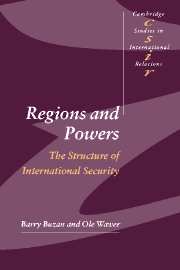Book contents
- Frontmatter
- Contents
- List of illustrations
- Preface
- List of abbreviations
- 1 Patterns of regional security during the Cold War
- 2 Patterns of regional security post-Cold War
- Part I Introduction: developing a regional approach to global security
- Part II Asia
- Part III The Middle East and Africa
- Part IV The Americas
- Part V The Europes
- Part VI Conclusions
- Introduction
- 14 Regions and powers: summing up and looking ahead
- 15 Reflections on conceptualising international security
- Glossary
- References
- News media
- Index of names
- General Index
- CAMBRIDGE STUDIES IN INTERNATIONAL RELATIONS
14 - Regions and powers: summing up and looking ahead
Published online by Cambridge University Press: 05 December 2009
- Frontmatter
- Contents
- List of illustrations
- Preface
- List of abbreviations
- 1 Patterns of regional security during the Cold War
- 2 Patterns of regional security post-Cold War
- Part I Introduction: developing a regional approach to global security
- Part II Asia
- Part III The Middle East and Africa
- Part IV The Americas
- Part V The Europes
- Part VI Conclusions
- Introduction
- 14 Regions and powers: summing up and looking ahead
- 15 Reflections on conceptualising international security
- Glossary
- References
- News media
- Index of names
- General Index
- CAMBRIDGE STUDIES IN INTERNATIONAL RELATIONS
Summary
Introduction: the structure of international security
In part I we differentiated global from regional level security dynamics, arguing that the best understanding of the structure of global security could be achieved by treating these levels as distinct, and seeing how they played into each other. Within the global level we established a distinction between superpowers and great powers, differentiating both from regional powers. On the basis of this scheme we then unfolded a story whose broad outlines were as follows:
During the interwar period there was a 3 + 3 global power structure, with Britain, the USA, and the Soviet Union as superpowers, and Germany, Japan, and France as great powers. Africa, the Middle East, and most of Asia remained overlaid by the control of colonial powers, and RSCs were visible only in North and South America, Europe, and Northeast Asia – a total of four.
During the Cold War/decolonisation period there was a 2 + 3 global power structure, with the USA and the Soviet Union as superpowers, and China, Japan, and the EU becoming great powers, albeit with the EU leaving room for questions about the standing of Britain, France, and Germany as independent players, perhaps only of regional status when taken individually. This period saw many new RSCs form (though the longstanding one in Europe disappeared under overlay) giving the following totals: three in Africa (counting the pre- and proto-complexes), three in Asia, one in South America, one in North America, none in Europe, and one in the Middle East – a total of ten.
[…]
- Type
- Chapter
- Information
- Regions and PowersThe Structure of International Security, pp. 445 - 460Publisher: Cambridge University PressPrint publication year: 2003
- 1
- Cited by



